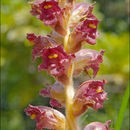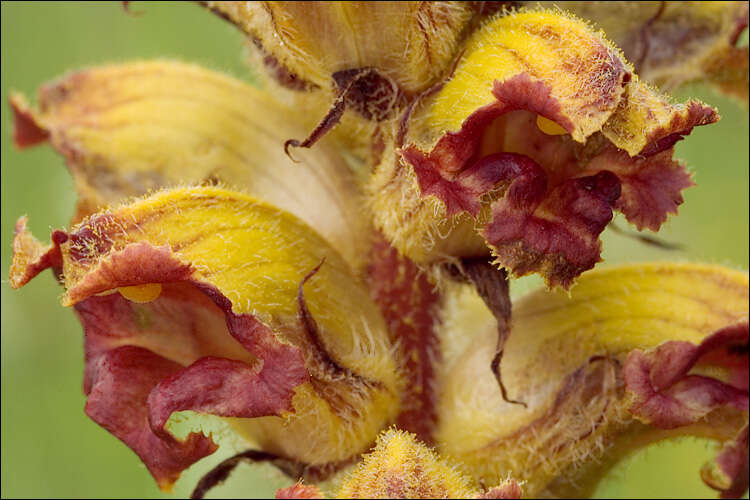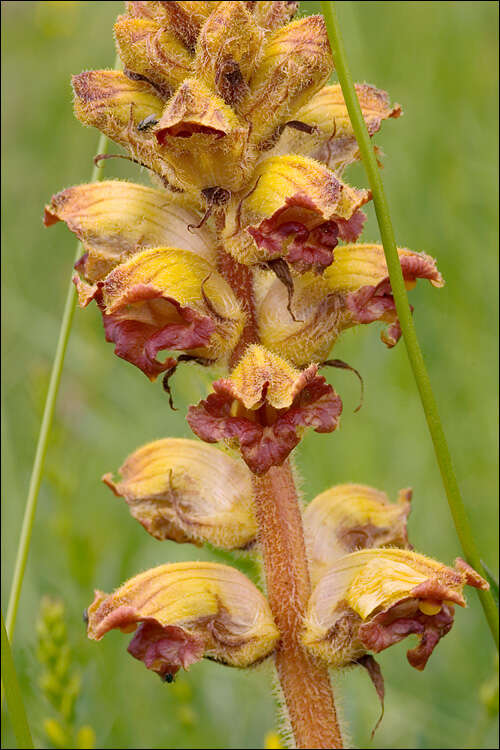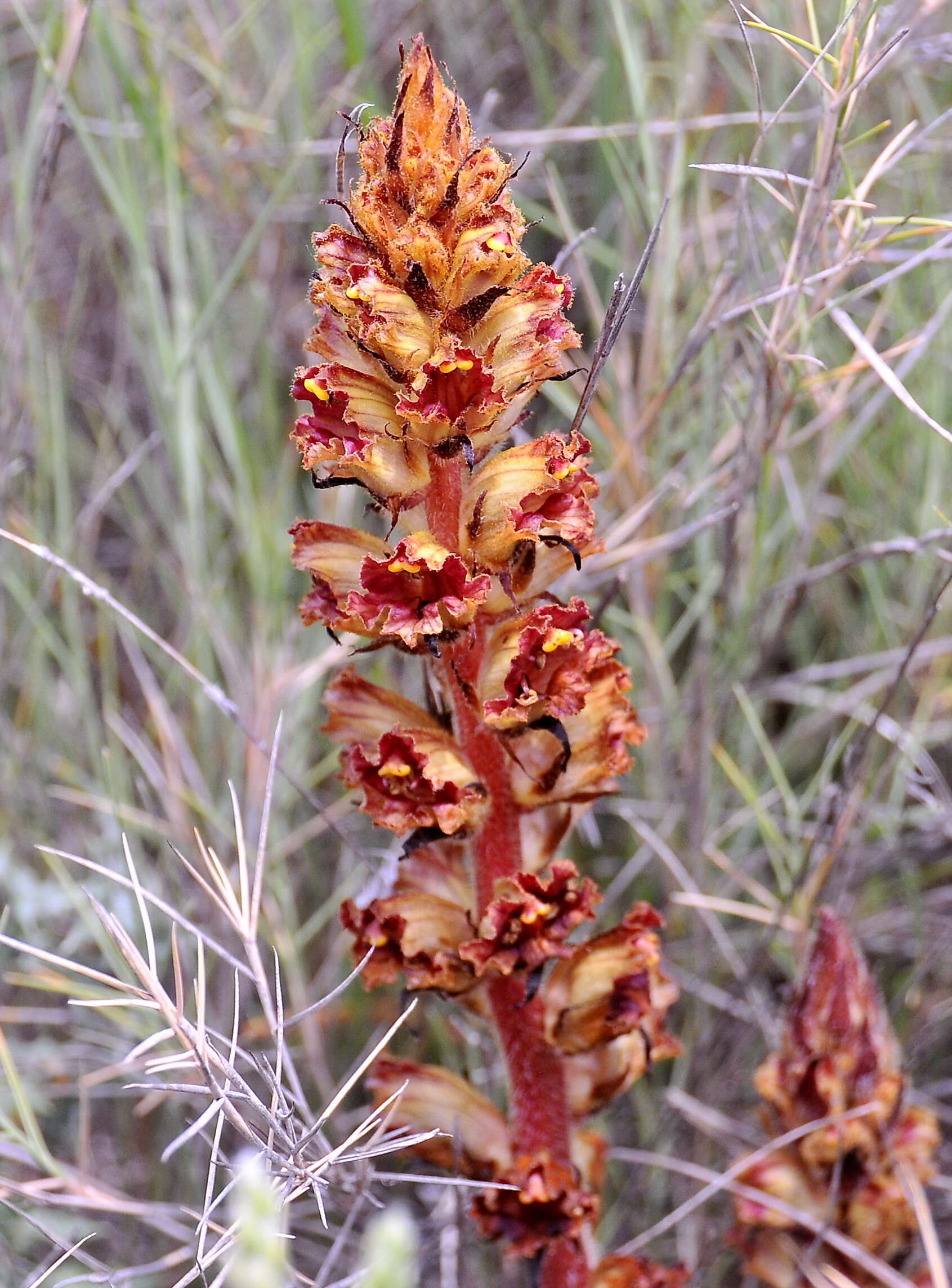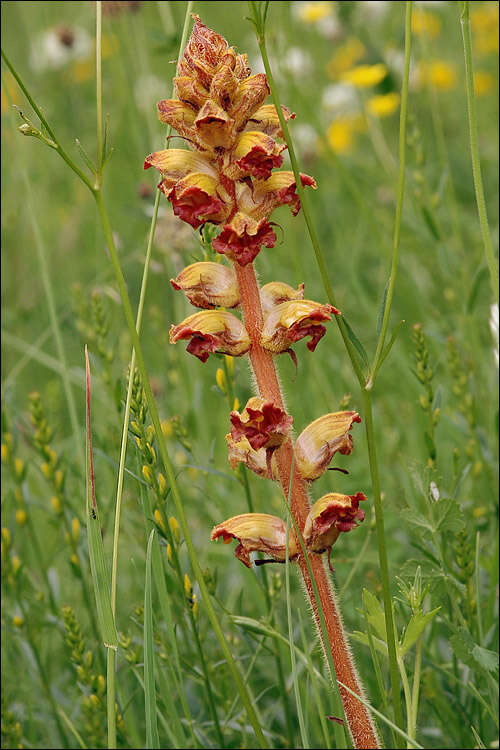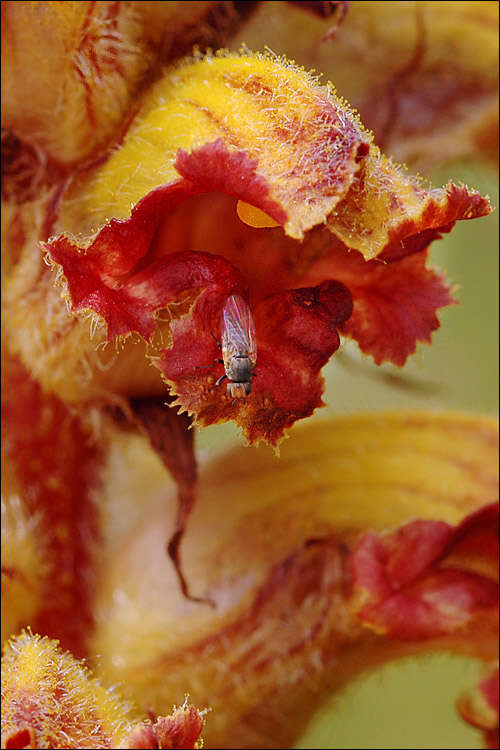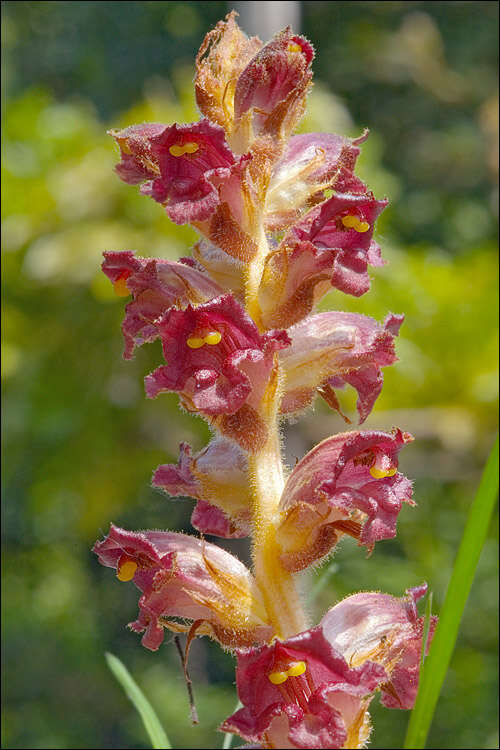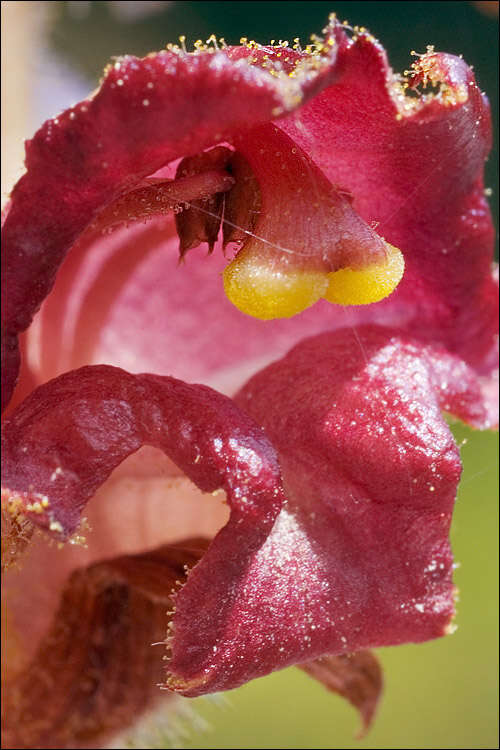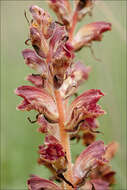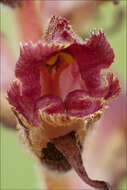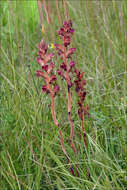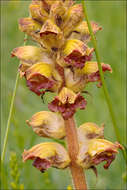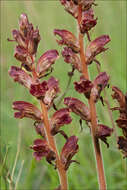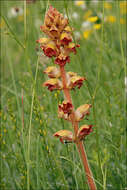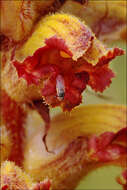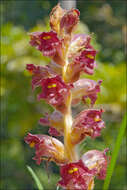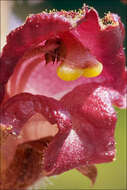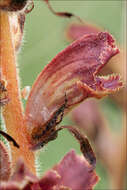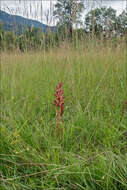-
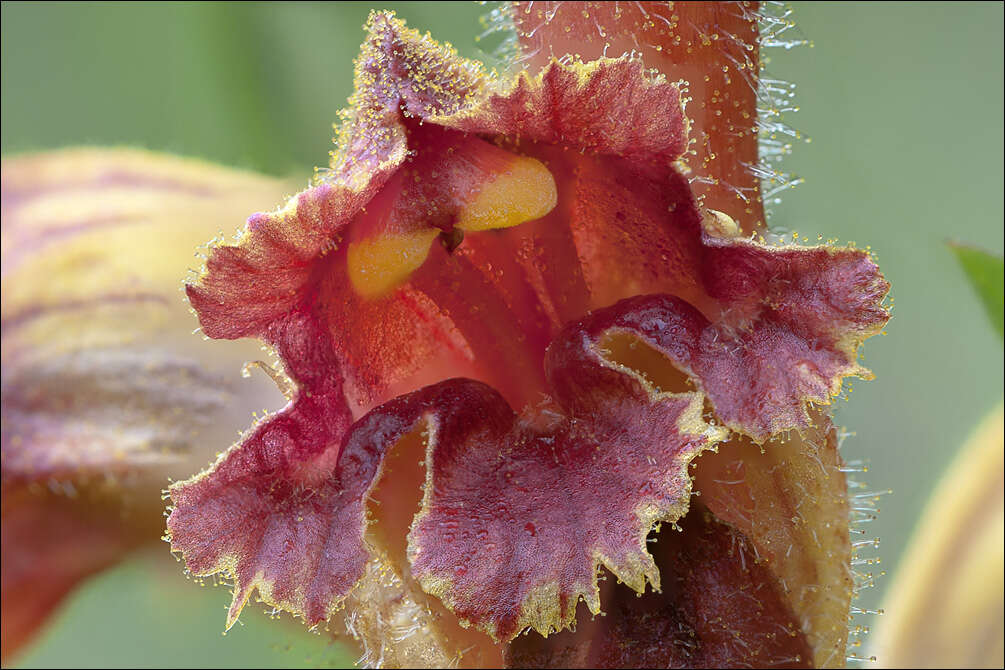
Orobanche gracilis Sm., syn.: Orobanche cruentaSlender BroomrapeSlo.: neni pojalnikDat.: June 16. 2014Lat.: 46.22191 Long.: 13.60969Code: Bot_805/2014_DSC1242 Habitat: dry grassland, mowed once per year, flat terrain, calcareous ground, overgrown old river deposits, full sun, exposed to direct rain, average precipitations ~ 3.000 mm/year, average temperature 8-10 deg C, elevation 355 m (1.150 feet), alpine phytogeographical region. Substratum: soil.Place: River Soa valley, downstream of Idrsko village, right bank of river Soa, between the river and main road Kobarid-Tolmin, East Julian Alps, Posoje, Slovenia EC Comment: Members of the genus Orobanche s.lat (Broomrapes) are extraordinarily fascinating plants in a similar way as Orchids. They have no chlorophyll and take food from their hosts. Similar like Orchids, which can't grow without a symbiotic relation with fungi, Orobanche can't grow without pure parasitic relation with specific green plants. While with Orchids both participating partners have some kind of benefit from the common life, with Orobanche only they profit while the other side pays the bill. The hosts regularly remain underdeveloped and crippled and do not bloom.In general Orobanche can be considered as a quite rare plant in nature, particularly some species of this genus. They are far of being numerous or aggressive and therefore their parasitic life style does not 'harm' nature significantly. However, this ceases to be true when men start to 'arrange' nature - in agriculture. Some species of this genus have become real plagues and large monoculture fields can be totally devastated by them. The reason lies in the way of their propagation. A single plant can produce up to several hundred thousand of seeds, which are like dust and among the smallest in the world. But, a seed can germinate only in case that the wind deposits it directly on the roots of a sometimes very specific host plant. So, only very, very small percentage of these seeds actually germinates thus keeping the number of new plants in proportions. Not so in large agricultural fields. Unfortunately, several suitable host plants are at the same time also agriculturally important. In such fields there are plenty of host's roots there; actually each root is just the right one for the seeds. Consequently Orobanche plants may occur in stands numbering millions and crop plants are 'suck' dry unable to flower and produce fruit. Instead of fields full of tobacco or clover a flood of these botanical 'rarities' is the result.Determination of plants to species level in this genus is difficult from several reasons. But, in spite of the fact that Orobanche gracilis is very variable plant (size, color, etc), it is actually an exception in this respect. It can be relatively easily recognized by unique blood red inner side of corolla and bright yellow stigma having a purple red margin. Its hosts are numerous and thus of little help in determination because it parasitizes on many plants of several genera within the large pea famili (Fabaceae). Ref.:(1) M.A. Fischer, W. Adler, K. Oswald, Exkursionsflora sterreich Liechtenstein, Sdtirol, LO Landesmuseen, Linz, Austria (2005), p 757.(2) A. Martini et all., Mala Flora Slovenije, Tehnina Zaloba Slovenije (2007) (in Slovene), p 573. (3) C.A.J. Kreutz, Orobanche, The European broomrape species: a field guide, Natuurhistorisch Genootschap Limburg, NL (1995), p 100.
-
Orobanche gracilisSlender BroomrapeSlo.: neni pojalnik3. Dat.: June 03. 2008Lat.: 46.33875 Long.: 13.53335Code: Bot_568/2008_8863 Habitat: Grassland, nearly flat terrain, full sun, quiet wet place, exposed to direct rain, average precipitations ~ 3.000 mm/year, average temperature 8-10 deg C, elevation 520 m (1.700 feet), alpine phytogeographical region. Substratum: soil. Place: Bovec basin, above the paved road to village Pluna, East Julian Alps, Posoje, Slovenia EC Comment: Growing solitary. Ref.:(1) M.A.Fischer, W.Adler, K.Oswald, Exkursionsflora Oesterreich Liechtenstein, Suedtirol, LO Landesmuseen, Linz, Austria (2005), p 758. (2) A.Martini et all., Mala Flora Slovenije, Tehnina Zaloba Slovenije (2007), p 577.
-
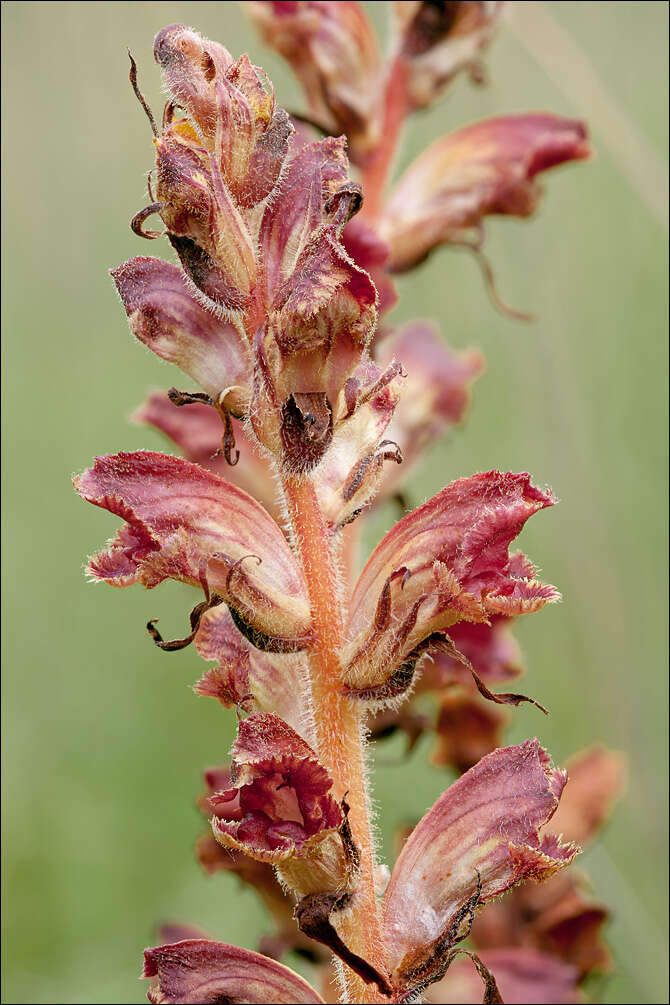
Orobanche gracilis Sm., syn.: Orobanche cruentaSlender BroomrapeSlo.: neni pojalnikDat.: June 16. 2014Lat.: 46.22191 Long.: 13.60969Code: Bot_805/2014_DSC1242 Habitat: dry grassland, mowed once per year, flat terrain, calcareous ground, overgrown old river deposits, full sun, exposed to direct rain, average precipitations ~ 3.000 mm/year, average temperature 8-10 deg C, elevation 355 m (1.150 feet), alpine phytogeographical region. Substratum: soil.Place: River Soa valley, downstream of Idrsko village, right bank of river Soa, between the river and main road Kobarid-Tolmin, East Julian Alps, Posoje, Slovenia EC Comment: Members of the genus Orobanche s.lat (Broomrapes) are extraordinarily fascinating plants in a similar way as Orchids. They have no chlorophyll and take food from their hosts. Similar like Orchids, which can't grow without a symbiotic relation with fungi, Orobanche can't grow without pure parasitic relation with specific green plants. While with Orchids both participating partners have some kind of benefit from the common life, with Orobanche only they profit while the other side pays the bill. The hosts regularly remain underdeveloped and crippled and do not bloom.In general Orobanche can be considered as a quite rare plant in nature, particularly some species of this genus. They are far of being numerous or aggressive and therefore their parasitic life style does not 'harm' nature significantly. However, this ceases to be true when men start to 'arrange' nature - in agriculture. Some species of this genus have become real plagues and large monoculture fields can be totally devastated by them. The reason lies in the way of their propagation. A single plant can produce up to several hundred thousand of seeds, which are like dust and among the smallest in the world. But, a seed can germinate only in case that the wind deposits it directly on the roots of a sometimes very specific host plant. So, only very, very small percentage of these seeds actually germinates thus keeping the number of new plants in proportions. Not so in large agricultural fields. Unfortunately, several suitable host plants are at the same time also agriculturally important. In such fields there are plenty of host's roots there; actually each root is just the right one for the seeds. Consequently Orobanche plants may occur in stands numbering millions and crop plants are 'suck' dry unable to flower and produce fruit. Instead of fields full of tobacco or clover a flood of these botanical 'rarities' is the result.Determination of plants to species level in this genus is difficult from several reasons. But, in spite of the fact that Orobanche gracilis is very variable plant (size, color, etc), it is actually an exception in this respect. It can be relatively easily recognized by unique blood red inner side of corolla and bright yellow stigma having a purple red margin. Its hosts are numerous and thus of little help in determination because it parasitizes on many plants of several genera within the large pea famili (Fabaceae). Ref.:(1) M.A. Fischer, W. Adler, K. Oswald, Exkursionsflora sterreich Liechtenstein, Sdtirol, LO Landesmuseen, Linz, Austria (2005), p 757.(2) A. Martini et all., Mala Flora Slovenije, Tehnina Zaloba Slovenije (2007) (in Slovene), p 573. (3) C.A.J. Kreutz, Orobanche, The European broomrape species: a field guide, Natuurhistorisch Genootschap Limburg, NL (1995), p 100.
-

Orobanche gracilis Sm., syn.: Orobanche cruentaSlender BroomrapeSlo.: neni pojalnikDat.: June 16. 2014Lat.: 46.22191 Long.: 13.60969Code: Bot_805/2014_DSC1242 Habitat: dry grassland, mowed once per year, flat terrain, calcareous ground, overgrown old river deposits, full sun, exposed to direct rain, average precipitations ~ 3.000 mm/year, average temperature 8-10 deg C, elevation 355 m (1.150 feet), alpine phytogeographical region. Substratum: soil.Place: River Soa valley, downstream of Idrsko village, right bank of river Soa, between the river and main road Kobarid-Tolmin, East Julian Alps, Posoje, Slovenia EC Comment: Members of the genus Orobanche s.lat (Broomrapes) are extraordinarily fascinating plants in a similar way as Orchids. They have no chlorophyll and take food from their hosts. Similar like Orchids, which can't grow without a symbiotic relation with fungi, Orobanche can't grow without pure parasitic relation with specific green plants. While with Orchids both participating partners have some kind of benefit from the common life, with Orobanche only they profit while the other side pays the bill. The hosts regularly remain underdeveloped and crippled and do not bloom.In general Orobanche can be considered as a quite rare plant in nature, particularly some species of this genus. They are far of being numerous or aggressive and therefore their parasitic life style does not 'harm' nature significantly. However, this ceases to be true when men start to 'arrange' nature - in agriculture. Some species of this genus have become real plagues and large monoculture fields can be totally devastated by them. The reason lies in the way of their propagation. A single plant can produce up to several hundred thousand of seeds, which are like dust and among the smallest in the world. But, a seed can germinate only in case that the wind deposits it directly on the roots of a sometimes very specific host plant. So, only very, very small percentage of these seeds actually germinates thus keeping the number of new plants in proportions. Not so in large agricultural fields. Unfortunately, several suitable host plants are at the same time also agriculturally important. In such fields there are plenty of host's roots there; actually each root is just the right one for the seeds. Consequently Orobanche plants may occur in stands numbering millions and crop plants are 'suck' dry unable to flower and produce fruit. Instead of fields full of tobacco or clover a flood of these botanical 'rarities' is the result.Determination of plants to species level in this genus is difficult from several reasons. But, in spite of the fact that Orobanche gracilis is very variable plant (size, color, etc), it is actually an exception in this respect. It can be relatively easily recognized by unique blood red inner side of corolla and bright yellow stigma having a purple red margin. Its hosts are numerous and thus of little help in determination because it parasitizes on many plants of several genera within the large pea famili (Fabaceae). Ref.:(1) M.A. Fischer, W. Adler, K. Oswald, Exkursionsflora sterreich Liechtenstein, Sdtirol, LO Landesmuseen, Linz, Austria (2005), p 757.(2) A. Martini et all., Mala Flora Slovenije, Tehnina Zaloba Slovenije (2007) (in Slovene), p 573. (3) C.A.J. Kreutz, Orobanche, The European broomrape species: a field guide, Natuurhistorisch Genootschap Limburg, NL (1995), p 100.
-
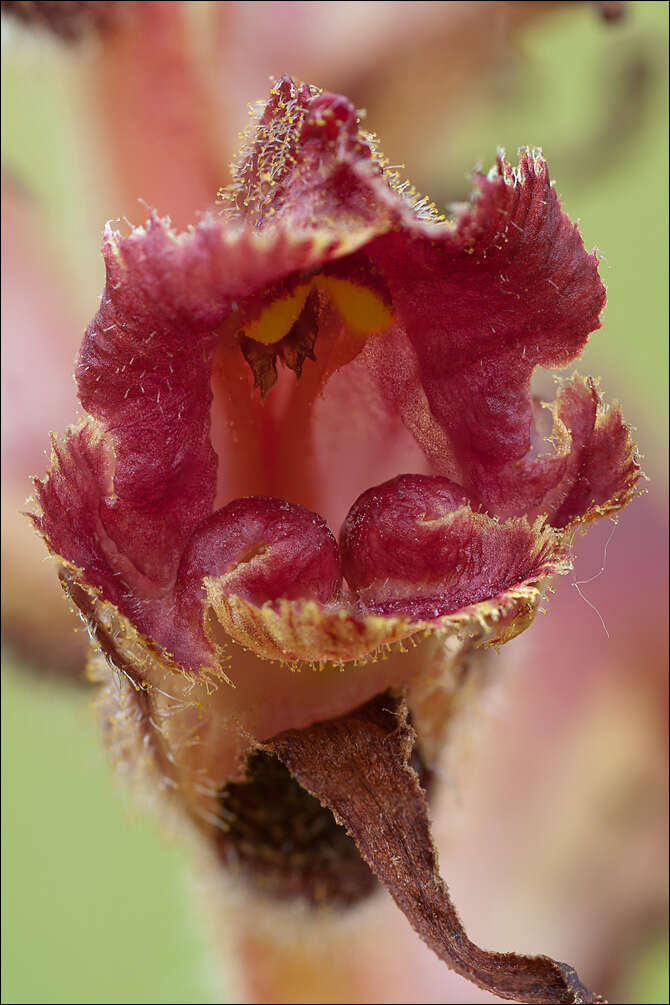
Orobanche gracilis Sm., syn.: Orobanche cruentaSlender BroomrapeSlo.: neni pojalnikDat.: June 16. 2014Lat.: 46.22191 Long.: 13.60969Code: Bot_805/2014_DSC1242 Habitat: dry grassland, mowed once per year, flat terrain, calcareous ground, overgrown old river deposits, full sun, exposed to direct rain, average precipitations ~ 3.000 mm/year, average temperature 8-10 deg C, elevation 355 m (1.150 feet), alpine phytogeographical region. Substratum: soil.Place: River Soa valley, downstream of Idrsko village, right bank of river Soa, between the river and main road Kobarid-Tolmin, East Julian Alps, Posoje, Slovenia EC Comment: Members of the genus Orobanche s.lat (Broomrapes) are extraordinarily fascinating plants in a similar way as Orchids. They have no chlorophyll and take food from their hosts. Similar like Orchids, which can't grow without a symbiotic relation with fungi, Orobanche can't grow without pure parasitic relation with specific green plants. While with Orchids both participating partners have some kind of benefit from the common life, with Orobanche only they profit while the other side pays the bill. The hosts regularly remain underdeveloped and crippled and do not bloom.In general Orobanche can be considered as a quite rare plant in nature, particularly some species of this genus. They are far of being numerous or aggressive and therefore their parasitic life style does not 'harm' nature significantly. However, this ceases to be true when men start to 'arrange' nature - in agriculture. Some species of this genus have become real plagues and large monoculture fields can be totally devastated by them. The reason lies in the way of their propagation. A single plant can produce up to several hundred thousand of seeds, which are like dust and among the smallest in the world. But, a seed can germinate only in case that the wind deposits it directly on the roots of a sometimes very specific host plant. So, only very, very small percentage of these seeds actually germinates thus keeping the number of new plants in proportions. Not so in large agricultural fields. Unfortunately, several suitable host plants are at the same time also agriculturally important. In such fields there are plenty of host's roots there; actually each root is just the right one for the seeds. Consequently Orobanche plants may occur in stands numbering millions and crop plants are 'suck' dry unable to flower and produce fruit. Instead of fields full of tobacco or clover a flood of these botanical 'rarities' is the result.Determination of plants to species level in this genus is difficult from several reasons. But, in spite of the fact that Orobanche gracilis is very variable plant (size, color, etc), it is actually an exception in this respect. It can be relatively easily recognized by unique blood red inner side of corolla and bright yellow stigma having a purple red margin. Its hosts are numerous and thus of little help in determination because it parasitizes on many plants of several genera within the large pea famili (Fabaceae). Ref.:(1) M.A. Fischer, W. Adler, K. Oswald, Exkursionsflora sterreich Liechtenstein, Sdtirol, LO Landesmuseen, Linz, Austria (2005), p 757.(2) A. Martini et all., Mala Flora Slovenije, Tehnina Zaloba Slovenije (2007) (in Slovene), p 573. (3) C.A.J. Kreutz, Orobanche, The European broomrape species: a field guide, Natuurhistorisch Genootschap Limburg, NL (1995), p 100.
-
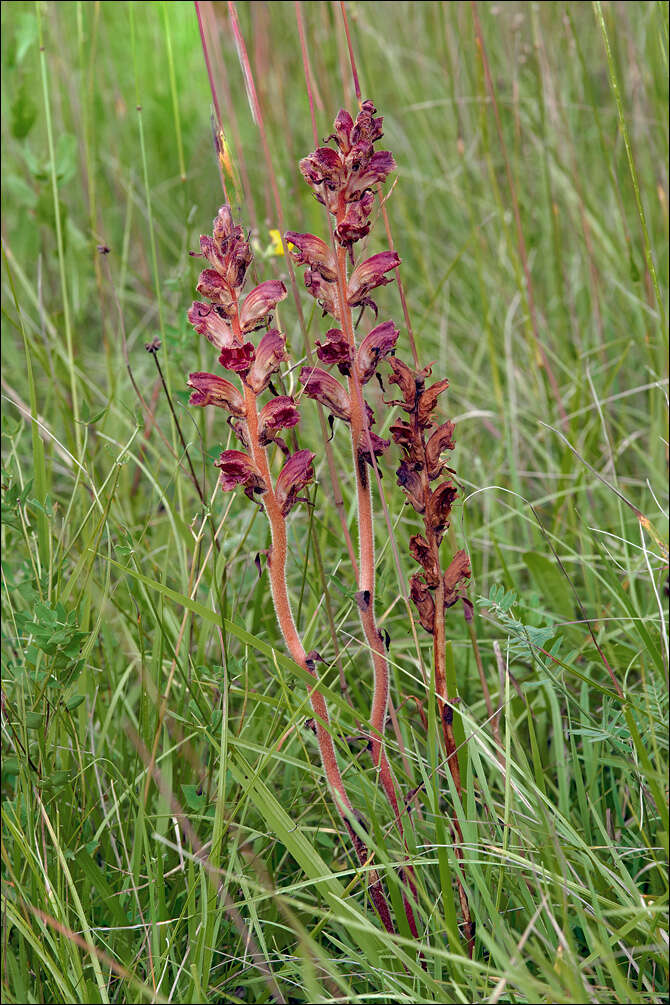
Orobanche gracilis Sm., syn.: Orobanche cruentaSlender BroomrapeSlo.: neni pojalnikDat.: June 16. 2014Lat.: 46.22191 Long.: 13.60969Code: Bot_805/2014_DSC1242 Habitat: dry grassland, mowed once per year, flat terrain, calcareous ground, overgrown old river deposits, full sun, exposed to direct rain, average precipitations ~ 3.000 mm/year, average temperature 8-10 deg C, elevation 355 m (1.150 feet), alpine phytogeographical region. Substratum: soil.Place: River Soa valley, downstream of Idrsko village, right bank of river Soa, between the river and main road Kobarid-Tolmin, East Julian Alps, Posoje, Slovenia EC Comment: Members of the genus Orobanche s.lat (Broomrapes) are extraordinarily fascinating plants in a similar way as Orchids. They have no chlorophyll and take food from their hosts. Similar like Orchids, which can't grow without a symbiotic relation with fungi, Orobanche can't grow without pure parasitic relation with specific green plants. While with Orchids both participating partners have some kind of benefit from the common life, with Orobanche only they profit while the other side pays the bill. The hosts regularly remain underdeveloped and crippled and do not bloom.In general Orobanche can be considered as a quite rare plant in nature, particularly some species of this genus. They are far of being numerous or aggressive and therefore their parasitic life style does not 'harm' nature significantly. However, this ceases to be true when men start to 'arrange' nature - in agriculture. Some species of this genus have become real plagues and large monoculture fields can be totally devastated by them. The reason lies in the way of their propagation. A single plant can produce up to several hundred thousand of seeds, which are like dust and among the smallest in the world. But, a seed can germinate only in case that the wind deposits it directly on the roots of a sometimes very specific host plant. So, only very, very small percentage of these seeds actually germinates thus keeping the number of new plants in proportions. Not so in large agricultural fields. Unfortunately, several suitable host plants are at the same time also agriculturally important. In such fields there are plenty of host's roots there; actually each root is just the right one for the seeds. Consequently Orobanche plants may occur in stands numbering millions and crop plants are 'suck' dry unable to flower and produce fruit. Instead of fields full of tobacco or clover a flood of these botanical 'rarities' is the result.Determination of plants to species level in this genus is difficult from several reasons. But, in spite of the fact that Orobanche gracilis is very variable plant (size, color, etc), it is actually an exception in this respect. It can be relatively easily recognized by unique blood red inner side of corolla and bright yellow stigma having a purple red margin. Its hosts are numerous and thus of little help in determination because it parasitizes on many plants of several genera within the large pea famili (Fabaceae). Ref.:(1) M.A. Fischer, W. Adler, K. Oswald, Exkursionsflora sterreich Liechtenstein, Sdtirol, LO Landesmuseen, Linz, Austria (2005), p 757.(2) A. Martini et all., Mala Flora Slovenije, Tehnina Zaloba Slovenije (2007) (in Slovene), p 573. (3) C.A.J. Kreutz, Orobanche, The European broomrape species: a field guide, Natuurhistorisch Genootschap Limburg, NL (1995), p 100.
-
Orobanche gracilisSlender BroomrapeSlo.: neni pojalnik3. Dat.: June 03. 2008Lat.: 46.33875 Long.: 13.53335Code: Bot_568/2008_8863 Habitat: Grassland, nearly flat terrain, full sun, quiet wet place, exposed to direct rain, average precipitations ~ 3.000 mm/year, average temperature 8-10 deg C, elevation 520 m (1.700 feet), alpine phytogeographical region. Substratum: soil. Place: Bovec basin, above the paved road to village Pluna, East Julian Alps, Posoje, Slovenia EC Comment: Growing solitary. Ref.:(1) M.A.Fischer, W.Adler, K.Oswald, Exkursionsflora Oesterreich Liechtenstein, Suedtirol, LO Landesmuseen, Linz, Austria (2005), p 758. (2) A.Martini et all., Mala Flora Slovenije, Tehnina Zaloba Slovenije (2007), p 577.
-
Orobanche gracilisSlender BroomrapeSlo.: neni pojalnik3. Dat.: June 03. 2008Lat.: 46.33875 Long.: 13.53335Code: Bot_568/2008_8863 Habitat: Grassland, nearly flat terrain, full sun, quiet wet place, exposed to direct rain, average precipitations ~ 3.000 mm/year, average temperature 8-10 deg C, elevation 520 m (1.700 feet), alpine phytogeographical region. Substratum: soil. Place: Bovec basin, above the paved road to village Pluna, East Julian Alps, Posoje, Slovenia EC Comment: Growing solitary. Ref.:(1) M.A.Fischer, W.Adler, K.Oswald, Exkursionsflora Oesterreich Liechtenstein, Suedtirol, LO Landesmuseen, Linz, Austria (2005), p 758. (2) A.Martini et all., Mala Flora Slovenije, Tehnina Zaloba Slovenije (2007), p 577.
-

Orobanche gracilis Sm., syn.: Orobanche cruentaSlender BroomrapeSlo.: neni pojalnikDat.: June 16. 2014Lat.: 46.22191 Long.: 13.60969Code: Bot_805/2014_DSC1242 Habitat: dry grassland, mowed once per year, flat terrain, calcareous ground, overgrown old river deposits, full sun, exposed to direct rain, average precipitations ~ 3.000 mm/year, average temperature 8-10 deg C, elevation 355 m (1.150 feet), alpine phytogeographical region. Substratum: soil.Place: River Soa valley, downstream of Idrsko village, right bank of river Soa, between the river and main road Kobarid-Tolmin, East Julian Alps, Posoje, Slovenia EC Comment: Members of the genus Orobanche s.lat (Broomrapes) are extraordinarily fascinating plants in a similar way as Orchids. They have no chlorophyll and take food from their hosts. Similar like Orchids, which can't grow without a symbiotic relation with fungi, Orobanche can't grow without pure parasitic relation with specific green plants. While with Orchids both participating partners have some kind of benefit from the common life, with Orobanche only they profit while the other side pays the bill. The hosts regularly remain underdeveloped and crippled and do not bloom.In general Orobanche can be considered as a quite rare plant in nature, particularly some species of this genus. They are far of being numerous or aggressive and therefore their parasitic life style does not 'harm' nature significantly. However, this ceases to be true when men start to 'arrange' nature - in agriculture. Some species of this genus have become real plagues and large monoculture fields can be totally devastated by them. The reason lies in the way of their propagation. A single plant can produce up to several hundred thousand of seeds, which are like dust and among the smallest in the world. But, a seed can germinate only in case that the wind deposits it directly on the roots of a sometimes very specific host plant. So, only very, very small percentage of these seeds actually germinates thus keeping the number of new plants in proportions. Not so in large agricultural fields. Unfortunately, several suitable host plants are at the same time also agriculturally important. In such fields there are plenty of host's roots there; actually each root is just the right one for the seeds. Consequently Orobanche plants may occur in stands numbering millions and crop plants are 'suck' dry unable to flower and produce fruit. Instead of fields full of tobacco or clover a flood of these botanical 'rarities' is the result.Determination of plants to species level in this genus is difficult from several reasons. But, in spite of the fact that Orobanche gracilis is very variable plant (size, color, etc), it is actually an exception in this respect. It can be relatively easily recognized by unique blood red inner side of corolla and bright yellow stigma having a purple red margin. Its hosts are numerous and thus of little help in determination because it parasitizes on many plants of several genera within the large pea famili (Fabaceae). Ref.:(1) M.A. Fischer, W. Adler, K. Oswald, Exkursionsflora sterreich Liechtenstein, Sdtirol, LO Landesmuseen, Linz, Austria (2005), p 757.(2) A. Martini et all., Mala Flora Slovenije, Tehnina Zaloba Slovenije (2007) (in Slovene), p 573. (3) C.A.J. Kreutz, Orobanche, The European broomrape species: a field guide, Natuurhistorisch Genootschap Limburg, NL (1995), p 100.
-
Estepa sur de Zaragoza. Aragn (Espaa)Familia: OROBANCHACEAESinnimos: Orobanche cruenta Bertol. Distribucin: NW de frica y Centro y S de Europa. Distribuda en casi toda la Pennsula Ibrica falta en las Islas Baleares.Hbitat: Pastos, matorrales, orlas y claros de bosque y, frecuentemente, en matorrales de etapa de degradacin del bosque. Parasita a leguminosas fruticosas, a veces sobre herbceas, de los gneros: Coronilla, Erinacea, Genista, Onobrychis, Trifolium.Preferencia edfica: Indiferente Rango altitudinal: ( 200 ) 600- 1700 ( 2350 ) m Floracin: ( Abril ) Mayo - JulioFructificacin: Junio - JulioForma Biolgica: Gefito parsitoExtractado del Atlas de la Flora de Aragn (Herbario de Jaca)
-
Orobanche gracilisSlender BroomrapeSlo.: nezni pojalnik3. Dat.: June 03. 2008Lat.: 46.33875 Long.: 13.53335Code: Bot_568/2008_8863 Habitat: Grassland, nearly flat terrain, full sun, quiet wet place, exposed to direct rain, average precipitations ~ 3.000 mm/year, average temperature 8-10 deg C, elevations 520 m (1.700 feet), alpine phytogeographical region. Substratum: soil. Place: Bovec basin, above the paved road to village Pluna, East Julian Alps, Posoje, Slovenia EC Comment: Growing solitary. Ref.:(1) M.A.Fischer, W.Adler, K.Oswald, Exkursionsflora Oesterreich Liechtenstein, Suedtirol, LO Landesmuseen, Linz, Austria (2005), p 758. (2) A.Martini et all., Mala Flora Slovenije, Tehnina Zaloba Slovenije (2007), p 577.
-
Orobanche gracilisSlender BroomrapeSlo.: nezni pojalnik3. Dat.: June 03. 2008Lat.: 46.33875 Long.: 13.53335Code: Bot_568/2008_8863 Habitat: Grassland, nearly flat terrain, full sun, quiet wet place, exposed to direct rain, average precipitations ~ 3.000 mm/year, average temperature 8-10 deg C, elevations 520 m (1.700 feet), alpine phytogeographical region. Substratum: soil. Place: Bovec basin, above the paved road to village Pluna, East Julian Alps, Posoje, Slovenia EC Comment: Growing solitary. Ref.:(1) M.A.Fischer, W.Adler, K.Oswald, Exkursionsflora Oesterreich Liechtenstein, Suedtirol, LO Landesmuseen, Linz, Austria (2005), p 758. (2) A.Martini et all., Mala Flora Slovenije, Tehnina Zaloba Slovenije (2007), p 577.
-
Orobanche gracilisSlender BroomrapeSlo.: neni pojalnik2.Date: May 17. 2006Lat.: 45.5759 Long.: 13.8562Code: Place: North of village Osp, altitude 110 m (360 feet), submediterranean phytogeographical region, Primorska, Slovenia ECRef.:(1) M.A.Fischer, W.Adler, K.Oswald, Exkursionsflora Oesterreich Liechtenstein, Suedtirol, LO Landesmuseen, Linz, Austria (2005), p 758. (2) A.Martini et all., Mala Flora Slovenije, Tehnina Zaloba Slovenije (2007), p 577. Nikon D70 / Nikkor Micro 105mm/f2.8
-
Orobanche gracilisSlender BroomrapeSlo.: neni pojalnik2.Date: May 17. 2006Lat.: 45.5759 Long.: 13.8562Code: Place: North of village Osp, altitude 110 m (360 feet), submediterranean phytogeographical region, Primorska, Slovenia ECRef.:(1) M.A.Fischer, W.Adler, K.Oswald, Exkursionsflora Oesterreich Liechtenstein, Suedtirol, LO Landesmuseen, Linz, Austria (2005), p 758. (2) A.Martini et all., Mala Flora Slovenije, Tehnina Zaloba Slovenije (2007), p 577. Nikon D70 / Nikkor Micro 105mm/f2.8
-
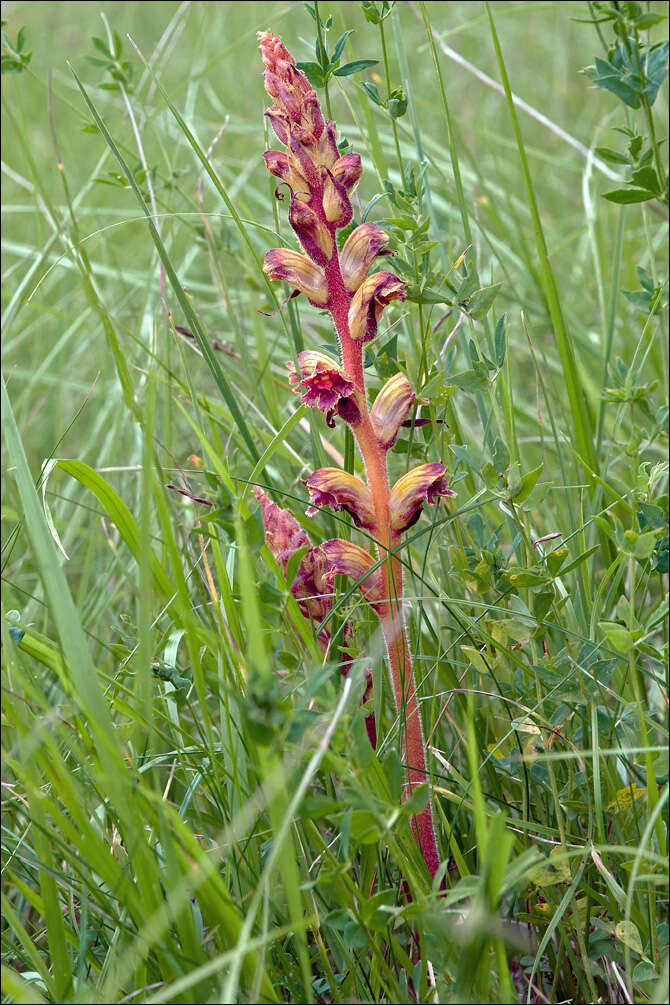
Orobanche gracilis Sm., syn.: Orobanche cruentaSlender BroomrapeSlo.: neni pojalnikDat.: June 16. 2014Lat.: 46.22191 Long.: 13.60969Code: Bot_805/2014_DSC1242 Habitat: dry grassland, mowed once per year, flat terrain, calcareous ground, overgrown old river deposits, full sun, exposed to direct rain, average precipitations ~ 3.000 mm/year, average temperature 8-10 deg C, elevation 355 m (1.150 feet), alpine phytogeographical region. Substratum: soil.Place: River Soa valley, downstream of Idrsko village, right bank of river Soa, between the river and main road Kobarid-Tolmin, East Julian Alps, Posoje, Slovenia EC Comment: Members of the genus Orobanche s.lat (Broomrapes) are extraordinarily fascinating plants in a similar way as Orchids. They have no chlorophyll and take food from their hosts. Similar like Orchids, which can't grow without a symbiotic relation with fungi, Orobanche can't grow without pure parasitic relation with specific green plants. While with Orchids both participating partners have some kind of benefit from the common life, with Orobanche only they profit while the other side pays the bill. The hosts regularly remain underdeveloped and crippled and do not bloom.In general Orobanche can be considered as a quite rare plant in nature, particularly some species of this genus. They are far of being numerous or aggressive and therefore their parasitic life style does not 'harm' nature significantly. However, this ceases to be true when men start to 'arrange' nature - in agriculture. Some species of this genus have become real plagues and large monoculture fields can be totally devastated by them. The reason lies in the way of their propagation. A single plant can produce up to several hundred thousand of seeds, which are like dust and among the smallest in the world. But, a seed can germinate only in case that the wind deposits it directly on the roots of a sometimes very specific host plant. So, only very, very small percentage of these seeds actually germinates thus keeping the number of new plants in proportions. Not so in large agricultural fields. Unfortunately, several suitable host plants are at the same time also agriculturally important. In such fields there are plenty of host's roots there; actually each root is just the right one for the seeds. Consequently Orobanche plants may occur in stands numbering millions and crop plants are 'suck' dry unable to flower and produce fruit. Instead of fields full of tobacco or clover a flood of these botanical 'rarities' is the result.Determination of plants to species level in this genus is difficult from several reasons. But, in spite of the fact that Orobanche gracilis is very variable plant (size, color, etc), it is actually an exception in this respect. It can be relatively easily recognized by unique blood red inner side of corolla and bright yellow stigma having a purple red margin. Its hosts are numerous and thus of little help in determination because it parasitizes on many plants of several genera within the large pea famili (Fabaceae). Ref.:(1) M.A. Fischer, W. Adler, K. Oswald, Exkursionsflora sterreich Liechtenstein, Sdtirol, LO Landesmuseen, Linz, Austria (2005), p 757.(2) A. Martini et all., Mala Flora Slovenije, Tehnina Zaloba Slovenije (2007) (in Slovene), p 573. (3) C.A.J. Kreutz, Orobanche, The European broomrape species: a field guide, Natuurhistorisch Genootschap Limburg, NL (1995), p 100.
-

Orobanche gracilis Sm., syn.: Orobanche cruentaSlender BroomrapeSlo.: neni pojalnikDat.: June 16. 2014Lat.: 46.22191 Long.: 13.60969Code: Bot_805/2014_DSC1242 Habitat: dry grassland, mowed once per year, flat terrain, calcareous ground, overgrown old river deposits, full sun, exposed to direct rain, average precipitations ~ 3.000 mm/year, average temperature 8-10 deg C, elevation 355 m (1.150 feet), alpine phytogeographical region. Substratum: soil.Place: River Soa valley, downstream of Idrsko village, right bank of river Soa, between the river and main road Kobarid-Tolmin, East Julian Alps, Posoje, Slovenia EC Comment: Members of the genus Orobanche s.lat (Broomrapes) are extraordinarily fascinating plants in a similar way as Orchids. They have no chlorophyll and take food from their hosts. Similar like Orchids, which can't grow without a symbiotic relation with fungi, Orobanche can't grow without pure parasitic relation with specific green plants. While with Orchids both participating partners have some kind of benefit from the common life, with Orobanche only they profit while the other side pays the bill. The hosts regularly remain underdeveloped and crippled and do not bloom.In general Orobanche can be considered as a quite rare plant in nature, particularly some species of this genus. They are far of being numerous or aggressive and therefore their parasitic life style does not 'harm' nature significantly. However, this ceases to be true when men start to 'arrange' nature - in agriculture. Some species of this genus have become real plagues and large monoculture fields can be totally devastated by them. The reason lies in the way of their propagation. A single plant can produce up to several hundred thousand of seeds, which are like dust and among the smallest in the world. But, a seed can germinate only in case that the wind deposits it directly on the roots of a sometimes very specific host plant. So, only very, very small percentage of these seeds actually germinates thus keeping the number of new plants in proportions. Not so in large agricultural fields. Unfortunately, several suitable host plants are at the same time also agriculturally important. In such fields there are plenty of host's roots there; actually each root is just the right one for the seeds. Consequently Orobanche plants may occur in stands numbering millions and crop plants are 'suck' dry unable to flower and produce fruit. Instead of fields full of tobacco or clover a flood of these botanical 'rarities' is the result.Determination of plants to species level in this genus is difficult from several reasons. But, in spite of the fact that Orobanche gracilis is very variable plant (size, color, etc), it is actually an exception in this respect. It can be relatively easily recognized by unique blood red inner side of corolla and bright yellow stigma having a purple red margin. Its hosts are numerous and thus of little help in determination because it parasitizes on many plants of several genera within the large pea famili (Fabaceae). Ref.:(1) M.A. Fischer, W. Adler, K. Oswald, Exkursionsflora sterreich Liechtenstein, Sdtirol, LO Landesmuseen, Linz, Austria (2005), p 757.(2) A. Martini et all., Mala Flora Slovenije, Tehnina Zaloba Slovenije (2007) (in Slovene), p 573. (3) C.A.J. Kreutz, Orobanche, The European broomrape species: a field guide, Natuurhistorisch Genootschap Limburg, NL (1995), p 100.
-

Orobanche gracilis Sm., syn.: Orobanche cruentaSlender BroomrapeSlo.: neni pojalnikDat.: June 16. 2014Lat.: 46.22191 Long.: 13.60969Code: Bot_805/2014_DSC1242 Habitat: dry grassland, mowed once per year, flat terrain, calcareous ground, overgrown old river deposits, full sun, exposed to direct rain, average precipitations ~ 3.000 mm/year, average temperature 8-10 deg C, elevation 355 m (1.150 feet), alpine phytogeographical region. Substratum: soil.Place: River Soa valley, downstream of Idrsko village, right bank of river Soa, between the river and main road Kobarid-Tolmin, East Julian Alps, Posoje, Slovenia EC Comment: Members of the genus Orobanche s.lat (Broomrapes) are extraordinarily fascinating plants in a similar way as Orchids. They have no chlorophyll and take food from their hosts. Similar like Orchids, which can't grow without a symbiotic relation with fungi, Orobanche can't grow without pure parasitic relation with specific green plants. While with Orchids both participating partners have some kind of benefit from the common life, with Orobanche only they profit while the other side pays the bill. The hosts regularly remain underdeveloped and crippled and do not bloom.In general Orobanche can be considered as a quite rare plant in nature, particularly some species of this genus. They are far of being numerous or aggressive and therefore their parasitic life style does not 'harm' nature significantly. However, this ceases to be true when men start to 'arrange' nature - in agriculture. Some species of this genus have become real plagues and large monoculture fields can be totally devastated by them. The reason lies in the way of their propagation. A single plant can produce up to several hundred thousand of seeds, which are like dust and among the smallest in the world. But, a seed can germinate only in case that the wind deposits it directly on the roots of a sometimes very specific host plant. So, only very, very small percentage of these seeds actually germinates thus keeping the number of new plants in proportions. Not so in large agricultural fields. Unfortunately, several suitable host plants are at the same time also agriculturally important. In such fields there are plenty of host's roots there; actually each root is just the right one for the seeds. Consequently Orobanche plants may occur in stands numbering millions and crop plants are 'suck' dry unable to flower and produce fruit. Instead of fields full of tobacco or clover a flood of these botanical 'rarities' is the result.Determination of plants to species level in this genus is difficult from several reasons. But, in spite of the fact that Orobanche gracilis is very variable plant (size, color, etc), it is actually an exception in this respect. It can be relatively easily recognized by unique blood red inner side of corolla and bright yellow stigma having a purple red margin. Its hosts are numerous and thus of little help in determination because it parasitizes on many plants of several genera within the large pea famili (Fabaceae). Ref.:(1) M.A. Fischer, W. Adler, K. Oswald, Exkursionsflora sterreich Liechtenstein, Sdtirol, LO Landesmuseen, Linz, Austria (2005), p 757.(2) A. Martini et all., Mala Flora Slovenije, Tehnina Zaloba Slovenije (2007) (in Slovene), p 573. (3) C.A.J. Kreutz, Orobanche, The European broomrape species: a field guide, Natuurhistorisch Genootschap Limburg, NL (1995), p 100.

